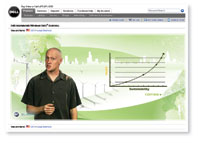
Part of Dell’s initiative includes a special website, the Greenprint Advisor, which openly shares sustainable packaging ideas with consumers and other businesses.
The Dell program is an ambitious one, and could well be a role model for any company, food and beverage manufacturers included. For one thing, Dell is deploying new technology in its packaging, specifically lightweight air-filled cushion technology in place of traditional paperboard. In addition, it will also be using high-density polyethylene thermal-formed cushions mainly from waste materials, a highly visible initiative relative to sustainability.
In addition, there is an interesting twist to this initiative-and a direct connection to food and beverage packaging: The waste materials used will be recycled milk jugs and household cleaner containers. Indeed, the computer maker is looking at using 33 million recycled milk jugs this year in creating lighter, better packaging for its products.
Dell is looking to reduce packaging by about 10% by 2010, and in doing so will shed $8 million annually in its packaging budget, save 150,000 trees, increase sustainable content in its cushioning and corrugated packaging by 40% and, with the help of those millions of milk jugs, ensure that 75% of packaging materials will be from curbside recyclables by 2012.
The reason why Dell is looking to turn itself into the “greenest technology company on the planet” is simple: customer and consumer pressure. Earlier this year, the company was subjected to an intense blog campaign relative to its packaging “excesses,” and it wisely responded with the current program.
Politicians are not about to let this issue go away either. Rep. Weiner (D-NY), albeit a publicity hound, recently staged a media event, highlighting packaging examples that overuse plastic. Rep. Weiner is introducing legislation that is aimed at reducing wasteful product packaging by 30% over the next decade. The proposed law is seeking new packaging regulations for consumer product packaging from the Environmental Protection Agency.
Moreover, the consumer press is now turning its attention to packaging. Stories with a lead like “now it’s time to take a look at how products are packaged, and how that packaging affects the environment” are growing in number and will almost certainly continue to do so. Prompts include purchasing products whose packaging content includes recycled materials, products that are in packaging that is recyclable and products from companies (like Dell) that are minimizing packaging, among other things.
In 2009 and beyond, green is going to not only be good, but likely essential, for a product to be successfully marketed. Not only will products have to meet ever more challenging green standards, but it is equally important that the program be effectively communicated not only to customers but to consumers as well.

Recent Comments
Custom Boxes
You are right, this is very important before...
You can find many inspiration from Instagram app...
Check out Honista app
Great Article!